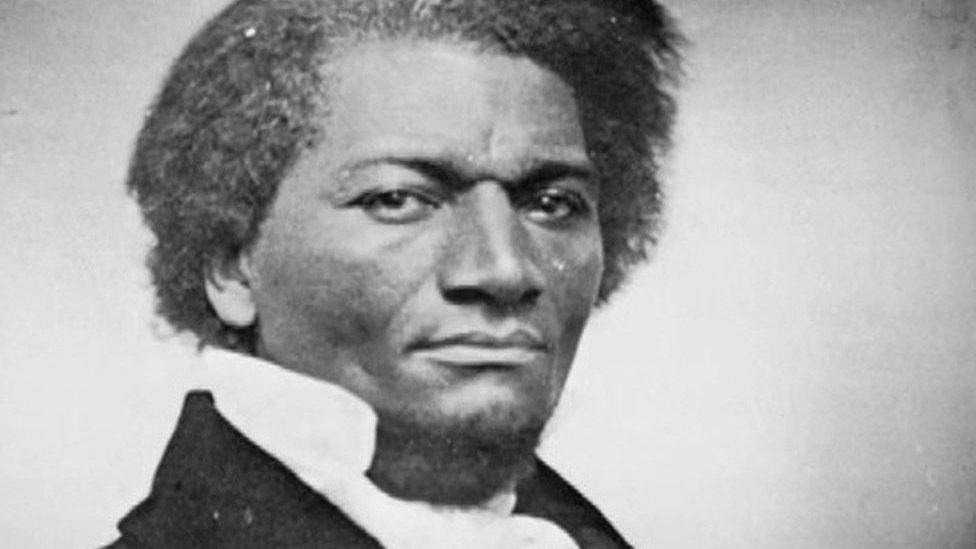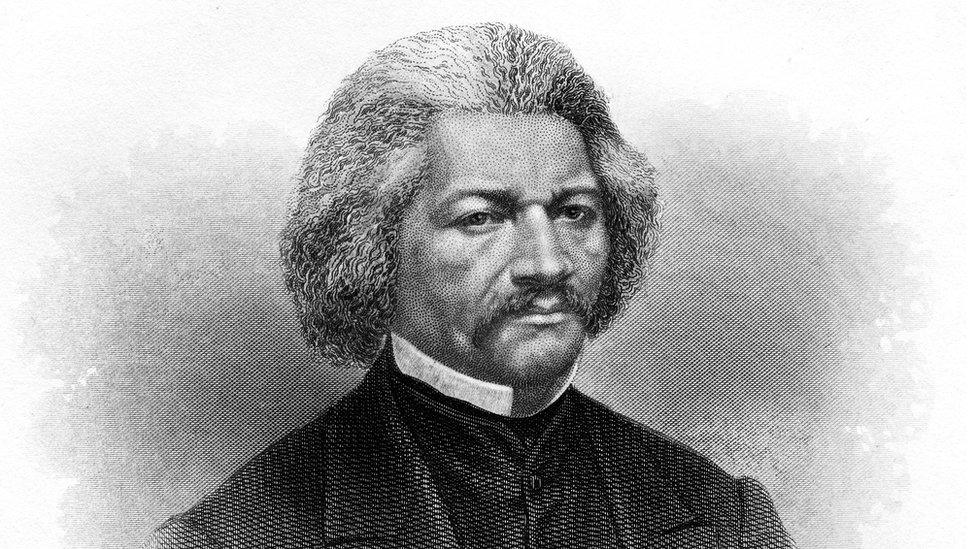Slavery: Belfast City Council approves statue of abolitionist
- Published

Frederick Douglass, who was born into slavery, said "truth is of no colour"
A proposal to erect a statue dedicated to US abolitionist and activist Frederick Douglass has been passed by Belfast City Council.
Douglass, a former slave, visited Belfast in 1845 as part of his lecturing tour of Ireland.
Last year, a specially-commissioned work by artist Aaron Hughes was hung on the walls of the Lord Mayor's parlour.
The proposal, brought by Sinn Féin, passed its final stage unanimously on Monday.
Belfast City Council confirmed the proposal had been ratified.
Councillor Ciaran Beattie said he was "delighted".
"The project will now move to the stage of design, and how we can create a creative and innovative tribute to a magnificent man and anti-racism trailblazer," he said.
The statue will be at Rosemary Street where Frederick Douglass addressed crowds in 1845.
Former Director of Anti-Slavery International, Aidan McQuade, told BBC Radio Ulster's Talkback programme Douglass was influenced by Irish reformers.
"He wrote in his memoirs that Daniel O'Connell was one of his inspirations because of O'Connell's outspoken anti-slavery sentiment at the time," he told BBC's Talkback programme.
"That was something that was quite deep in Irish society at the time.
"Not just O'Connell but people like Isaac Nelson, who was a minister on the Shankill Road, and Mary Ann McCracken who were outspoken anti-slavery advocates at the time," he said.
"Douglas coming to Ireland was tapping into that international movement.
"Commemorating his presence in Belfast reflects back onto that period in an important way, at a time when Catholic, Protestant and dissenter were united in a common cause and a common outward looking case - it's something Belfast can be deeply proud of," he added.
He described him as "one of the most significant leaders in the struggle against slavery in the 19th Century".
"He was, interestingly, the most photographed man in the 19th Century, which speaks a lot about what his status was," he added.


Who was Frederick Douglass?
Frederick Douglass was as born into slavery in Maryland in 1818 and, once he had escaped, became one of that century's most prominent abolitionists.
After he escaped, in 1838, he got married, changed his surname, and joined the anti-slavery movement.
He quickly became one of the most well known campaigners of his time, with a talent for public speaking, as he travelled around telling people about life as a slave.
He was such a good orator, his opponents doubted his story, but he told it in grim detail in 1845 in his book, Narrative of the Life of Frederick Douglass, an American Slave.
He went on to address huge audiences in Great Britain and Ireland and there some of his supporters paid off his owner, so Douglass could be free in law and not fear recapture.
After the Civil War and the abolition of slavery, he campaigned for equal rights for African-Americans, arguing against those such as Lincoln who had wanted freed slaves to leave America and found a colony elsewhere.
"We were born here," he said, "and here we will remain."
Celeste-Marie Bernier, Professor of Black Studies in the English Department at the University of Edinburgh, said the defining inspiration for his life was Harriet Bailey - his mother - a woman who had learnt how to read and write.

"This statue will not only be a tribute to Douglass, but also to the anti-racism movement in Belfast and across Ireland," said Mr Beattie.
"From Belfast to the world, this is a clear and unambiguous message - Black Lives Matter," he added.
Approval for the council to establish and lead the working group tasked with delivering the project was granted.
It was agreed that it should also "consider how the city's wider association with slavery during that period in history could be recognised."
- Published27 May 2018
